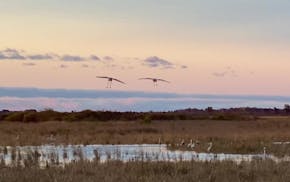Q Is it too late to seed my lawn?
A The timing for fall lawn seeding varies according to where you live.
In the Twin Cities metro area, mid-September is considered the cutoff date for seeding. Getting the seeds to sprout is not a problem in early fall, but the grass plants need time to develop a root system that's strong enough to survive winter. That's critical, and that takes longer. So seed now, if you can.
If you still want to seed later this fall, try dormant seeding. Here's how to do it: Prepare the area you wish to seed, then wait until just before the ground freezes to seed. By then, it'll be too cold for the seeds to sprout, but the seeds should sprout in spring as snow melts and the soil warms, provided we get good snow cover and the area remains undisturbed over winter.
Trapping beetles Q Is it possible to trap Japanese beetles?
A There are traps designed for Japanese beetles. They're typically "baited" with pheromones, the scent of beetle food or a combination of both. And they do succeed in luring large numbers of Japanese beetles.
However, most entomologists don't recommend using these traps because they attract more Japanese beetles into the area than would have been there without the traps. What's worse, not all of the beetles make it into the traps. Some will find their way to roses, raspberries or one of the many other plants on which they feed, where they leave lacy skeletons of leaves and shredded petals.
Unfortunately, there's not a great way to get rid of these voracious pests, aside from harvesting them by hand. Several insecticides are labeled for use on Japanese beetles, but they're not considered very effective, partly because the beetles are extremely mobile.
If you discover Japanese beetles in your garden next summer and decide to try traps, place the traps well away from the plants you wish to protect. While you may get a certain satisfaction from collecting and throwing out bags full of dead Japanese beetles, by using traps you're most likely making matters worse rather than better.
Making plants shine Q Is it OK to use leaf shine products on my houseplants? I'd like them to look clean and bright.
A Leaf shine products are not particularly good for your houseplants; neither are "natural" products such as milk or mayonnaise, which are sometimes recommended to give foliage a shine. Though leaves look clean and shiny after you use them, the residue left behind by these products attracts and holds dust and grime, leaving the foliage looking dirty again before long.
It's much better to clean houseplants with a simple mixture of lukewarm water and a few drops of mild dishwashing liquid. Dip a soft rag in the mixture and wipe the top and the underside of the leaves.
If you have plants with small leaves, spray them with the water mixture or give them a bath. Here's how: Fill a sink with lukewarm water and some dishwashing liquid. Cover the soil of the plant with tinfoil, then turn the plant upside down and swish the leaves through water.
And, finally, never dust your houseplants with a dry rag or feather duster. It's the perfect way to spread spider mites, other insects and their eggs from one plant to another.
Showy shrubs Q I've noticed a couple of unusual-looking shrubs. One is quite tall with maroon-colored leaves and huge purplish puffs on top. The other looks almost like an evergreen, but is spindly and has plumes of pink flowers at the top of each stem. What are they? I'd like to plant them in my yard.
A The purple-leaved plant is Cotinus coccygria, which goes by the common name smokebush.
It's named for the unique, smoke-like puffy structures that develop from clusters of small, insignificant flowers that appear earlier in the season. (There's also a green-leaved variety of smokebush, but purple ones are much showier.) Smokebush is thought to be marginally hardy here, but with the past few relatively mild winters we've experienced, many have grown quite large. They can suffer substantial die-back, however, during harsh, cold winters.
The second shrub is called tamarisk (Tamarix ramosissima). It's a problem plant in Colorado, but not here in Minnesota. Though not a conifer, its thin scale-like foliage gives it an evergreen appearance. Its foliage, combined with long-lasting, tiny pink flowers that develop throughout the summer, give it a delicate, lacy appearance. But this is one tough plant, which can be grown on poor soil and in dry, windy locations.
One word of caution: Because both of these shrubs are showy specimen plants, choose one or the other unless you have a big yard. Smokebush is better for a somewhat protected area. Tamarisk can be more exposed to the elements.
Deb Brown is a garden writer and former extension horticulturist with the University of Minnesota. To ask her a gardening question, call 612-673-7793 and leave a message. She will answer questions in this column only.

A Minnesota field guide to snow shovels: Which one's best?
Sign up for Star Tribune newsletters

